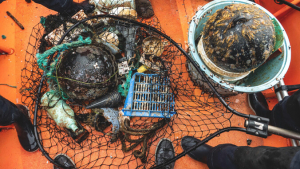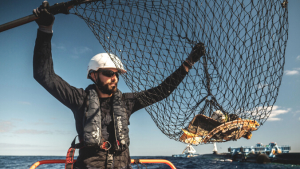Yet more evidence that nature finds ways to adapt to changing environments.
No, we don’t condone chucking plastic into the ocean, and ironically, we are aware that much of this plastic actually comes from the practice of sending container-loads of waste plastic to the East to be recycled, and much of it ending up in the sea whether by accident or design. I guess what I’m saying is, be responsible, don’t litter, do your part to fight the corruption and hypocrisy of big corporations, but don’t beat yourself up. Life goes on. Martin
From University of Hawai’i News
The high seas have been colonized by a surprising number of coastal marine invertebrate species, which can now survive and reproduce in the open ocean, contributing strongly to the floating community composition. This finding was published on April 17 in Nature Ecology and Evolution by a team of researchers led by the University of Hawaiʻi at Mānoa and the Smithsonian Environmental Research Center (SERC).

Coastal podded hydroid Aglaophenia pluma and open-ocean gooseneck barnacles Lepas living on floating plastic collected in the North Pacific Subtropical Gyre. (Photo courtesy of The Ocean Cleanup, in coordination with Smithsonian Institution)
The researchers found coastal species, representing diverse taxonomic groups and life history traits, in the eastern North Pacific Subtropical Gyre on more than 70% of the plastic debris they examined. Further, the debris carried more coastal species than open ocean species.
“This discovery suggests that past biogeographical boundaries among marine ecosystems—established for millions of years—are rapidly changing due to floating plastic pollution accumulating in the subtropical gyres,” said lead author Linsey Haram, research associate at SERC.
These researchers recently discovered the existence of these “neopelagic communities,” or floating communities in deep ocean waters. To understand the ecological and physical processes that govern communities on floating marine debris, SERC and UH Mānoa formed a multi-disciplinary Floating Ocean Ecosystem (FloatEco) team. UH Mānoa led the assessment of physical oceanography, and SERC evaluated biological and ecological dimensions of the study.
Human impact spreads coastal species

While scientists already knew organisms, including some coastal species, colonized marine plastic debris, scientists were unaware until now that established coastal communities could persist in the open ocean. These findings identify a new human-caused impact on the ocean, documenting the scale and potential consequences that were not previously understood.
“The Hawaiian Islands are neighbored in the northeast by the North Pacific garbage patch,” said Nikolai Maximenko, co-author and senior researcher at the UH Mānoa School of Ocean and Earth Science and Technology. “Debris that breaks off from this patch constitutes the majority of debris arriving on Hawaiian beaches and reefs. In the past, the fragile marine ecosystems of the islands were protected by the very long distances from coastal communities of Asia and North America. The presence of coastal species persisting in the North Pacific Subtropical Gyre near Hawaiʻi is a game changer that indicates that the islands are at an increased risk of colonization by invasive species.”
“Our study underscores the large knowledge gap and still limited understanding of rapidly changing open ocean ecosystems,” said co-author Gregory Ruiz, senior scientist at SERC. “This highlights the need for dramatic enhancement of the high-seas observing systems, including biological, physical and marine debris measurements.”
Samples turn up surprising finds

For this study, the FloatEco team analyzed 105 plastic samples collected by The Ocean Cleanup during their 2018 and 2019 expeditions in the North Pacific Subtropical Gyre, which occupies most of the northern Pacific Ocean.
“We were extremely surprised to find 37 different invertebrate species that normally live in coastal waters, over triple the number of species we found that live in open waters, not only surviving on the plastic but also reproducing,” said Haram. “We were also impressed by how easily coastal species colonized new floating items, including our own instruments—an observation we’re looking into further.”
“Our results suggest coastal organisms now are able to reproduce, grow and persist in the open ocean—creating a novel community that did not previously exist, being sustained by the vast and expanding sea of plastic debris,” said Ruiz. “This is a paradigm shift in what we consider to be barriers to the distribution and dispersal of coastal invertebrates.”
–By Marcie Grabowski
And on a similar theme of nature keeping things in check:

Get your copy from our Online Store or your local book and magazine retailer
Australian Retail Locations » Uncensored Publications Limited
New Zealand Retail Locations » Uncensored Publications Limited
As censorship heats up and free thought becomes an increasingly rare commodity, we appeal to our readers to support our efforts to reach people with information now being censored elsewhere. In the last few years, Uncensored has itself been censored, removed from the shelves of two of our biggest NZ retailers – Countdown Supermarkets and Whitcoulls Bookstores – accounting for 74% of our total NZ sales.
You can help keep the Free Press alive by subscribing and/or gifting a subscription to your friends and relatives.








